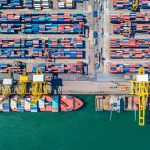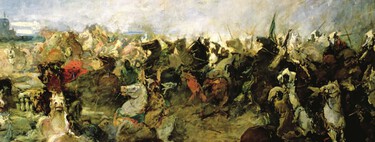Drought can appear at any time and in the most unexpected place. In fact, it never completely disappears, as we explained recently. Let’s take Spain as an example, which has been months above the average amount of dammed water for the last decade. Not even in this way can it be concluded that we have reached an “agreement” with water. And if we look at history, one case served as an example for the rest.
Large Dry. Behind this name there was a meteorological phenomenon that changed the perception of those who lived in areas where certain natural phenomena apparently could not reach. It occurred in the late 19th century in northeastern Brazil, but it could have occurred anywhere. That year we experienced one of the most unique and powerful weather patterns we know of.
It turns out that, at the time, the phenomenon was not attributable to climate change. So the equation of events was believed to be random or, to be more precise, it was thought to be due to the periodic and natural oscillations of the climate. The result: almost three years without precipitation, the death of nearly half a million people and the largest and most devastating drought in Brazilian history.
ENSO. Imagine that La Niña and El Niño alternate their functions by surprise. We call this event today the El Niño Southern Oscillation (ENSO), and it refers to fluctuations in ocean temperatures and atmospheric patterns in the tropical Pacific, including El Niño (warming waters) and La Niña (cooling). ).
However, in the case of the drought in Brazil, the phenomenon warmed the waters of the equatorial Pacific Ocean, modifying atmospheric circulation in a way that caused an extreme lack of rain. As? The onset of El Niño disrupted normal precipitation patterns in the northeast of the country, a region that already has a semi-arid climate and depends on seasonal rains. El Niño weakened the formation of monsoon rains, intensifying dry conditions for several consecutive years. A disaster.
First deserts. In January 1877 (mid-summer), Cearense noticed the first signs of hardship. Desperate letters from the dates already reflected the desolate panorama: “The lack of rain is already being felt. “From Sobral and other parts of the province they tell us that the drought is causing considerable damage.” In another letter, written in March, a man said: “We are suffering from a terrible drought… and only God knows how painful this scourge will be.” Another related: “The drought is devastating everything, the mortality of the cows is astonishing.”
The situation did not improve when March and the late rainy season gave way to winter. One correspondent from the municipality of Assaré feared total human annihilation in the surrounding countryside, while another lamented the “emaciated bodies of our small children, wives and parents.” A letter published several days before Christmas ended 1877 on a depressing note: “We are already in the middle of December and it is not raining! “The drought with all its procession of horrors continues, threatening to swallow everything.”


Effects. Officially, The Great Dry ended in 1878but its effects lasted much longer. The drought paralyzed Northeast sugar workers, who had seen their investments wither since the early 19th century. Cotton growers, whose business flourished during and after the American Civil War (1861-1865), also faced new headwinds, while ranchers tallied their losses in the hundreds of thousands of head.
The deadliest drought in Brazilian history, exacerbated by two consecutive years of exceptionally strong El Niño, therefore had a brutal economic impact, draining the area of much-needed capital and contributing to the region’s lackluster development. Because, above all, the victims and survivors of the drought They needed work, especially in Ceará.
Exodus. What happened then was a scene that has been repeated in history. Without livestock or crops, millions of desperate Ceará residents migrated to the main population centers in the hope of finding work. Among emigrants’ limited options, Brazil’s burgeoning rubber industry was particularly attractive, both for its relatively high wages and its geographical proximity. And of all the enclaves, most were going to end up in the capital, Fortaleza.
The shocking images of emaciated men, women and children became emblematic in the country. Let’s think that it was the first time that a drought was recorded in photographs in Brazil. Bottom line: raise public opinion and warn about the seriousness of the events that were occurring in the northern provinces, since some Brazilians in the south considered them an exaggeration. To give us an idea, the newspapers carried stories of women who prostituted themselves for food and of parents who sold and even they ate their own children.


The rubber boom. Brazilian rubber production, based in the Amazon Valley, specifically in the states of Amazonas and Pará, did not begin until the end of the 18th centuryafter French explorer Charles Marie de La Condamine first observed natives using a “milky, viscous liquid” from the Hevea Braziliensis tree to make boots, toys and bottles.
Exports of raw and rubber products They grew steadily until the beginning of the 19th century. Trade took off When Charles Goodyear discovered vulcanization in 1839, which made rubber resistant to extreme temperatures. However, rubber remained largely irrelevant in Brazil until its first boom in the 1880s, when price increases and an influx of cheap labor raised the product’s export share to 10%.
However, there was a shortage of labor, and the Grande Seca was a great opportunity for merchants.
Exploitation. The people of Ceará, hundreds of thousands of desperate migrants who ate what they found along the way, and whom the rubber industry “desperately needed,” cared little about working conditions as long as they received a salary, and that is why They accepted jobs that few daredincluding extracting hevea from trees in a hot, disease-ridden rainforest. In fact, during the great drought, Ceará became a fundamental state for labor recruiters from Amazonas and Pará.
Smallpox. In a context where health conditions and access to medical care were limited, the disease spread rapidlypartly due to poor health infrastructure and lack of immunization of the population. The port of Fortaleza, in the state of Ceará, became a focus of the epidemic due to its role in trade and the movement of people due to the drought, which facilitated the rapid spread of smallpox throughout the region.
Smallpox killed tens of thousands of people, many already weakened by famine resulting from the drought. Mortality was particularly high among the most disadvantaged classes and rural communities, where access to medical resources was almost non-existent. To top it off, government response was limitedpartly due to the lack of a coordinated health strategy at the national level.
A change. Everything that happened on these dates evidenced the need for improvements in public health policies and living conditions, which, although very late, later contributed to reforms in the health administration in the country. The 1878 epidemic left a deep mark on Brazilian history, reflecting society’s vulnerability to combined health and climate crises. Of course, a warning for any nation.

Notice to sailors. The Great Seca not only killed hundreds of thousands of northeasterners, but also caused a massive internal migration that was unprecedented until then. This last phenomenon was particularly problematic for the state of Ceará, from which thousands of people emigrated. The people of Ceará, in turn, provided the rubber “lords” of Amazonas and Pará with an invaluable source of cheap labor.
At the beginning of the new century, in 1900, the country exported more rubber than any other product, except coffee. Mass migration to the south of the country continued in the following decades, accelerating the urbanization and growth of cities such as São Paulo and Rio de Janeiro.
El Niño, in one way or another, forever marked the history of Brazil, and demonstrated to modern societies that climatic phenomena, no matter how seemingly distant they may seem from an enclave, are ready to test any community.
Image | Bmleite1Cândido Portinari, National Library
In Xataka | The water war: Mexico and the United States have headed towards an irremediable conflict over supplies
In Xataka | Europe is so dry that its rivers are revealing all kinds of treasures. Even a Nazi army from World War II


![[Img #74693]](https://thelatestnews.world/wp-content/uploads/2024/12/Give-a-second-life-to-your-mobile-with-iLevante-150x150.jpg)








![[Img #74693]](https://thelatestnews.world/wp-content/uploads/2024/12/Give-a-second-life-to-your-mobile-with-iLevante-300x200.jpg)

Add Comment